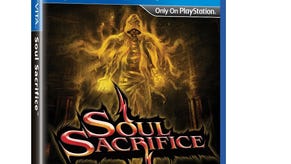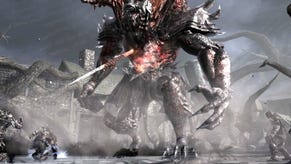Digital Foundry vs. Soul Sacrifice
Save yourself.
Despite being visually scaled back to work on hardware that is considerably weaker than Xbox 360 or PS3, games like Uncharted: Golden Abyss, Assassin's Creed: Liberation and Need For Speed: Most Wanted prove that the PlayStation Vita is capable of faithfully bringing triple-A console blockbusters to the small screen. However, the spectacle of playing expansive, big budget titles might not be the best fit for a portable gaming machine: recreating a similar level of detail is likely to have a considerable impact on performance, while the underlying gameplay mechanics may not gel well with the shorter play-times associated with gaming on the move.
Developed exclusively for the PlayStation Vita by Marvelous AQL in conjunction with Sony Japan Studio, and produced by the legendary Keiji Inafune, Soul Sacrifice doesn't make use of the system's more exotic features, but instead attempts to offer up the experience of a hardcore action title, but in a smaller, more manageable game designed around portable play. The focus is clear: levels are built around quick combat sessions that deliver instant gratification, rather than long sprawling missions that take hours to complete. Graphically, the developers have tried to replicate the large scope of home console titles by using stylish artwork to create a visually striking release, but on a much smaller scale suited to the PS Vita hardware.
The game also differs from other similar titles - think Demon's Souls and Monster Hunter - by fusing the whole experience around a outlandish premise: the entire adventure is told through the pages of a living book, Librom, with the player re-enacting past battles in order to enhance their abilities before challenging an evil sorcerer in the real world for freedom. This story-telling device is central to shaping the look and feel of the game: Librom drives the narrative forward, doling out new challenges and levels through its pages, which can be replayed multiple times, while the use of hand-written scripture textured across the skybox in some of the game's stages is also a nice touch, adding to the surreal nature of the stylised worlds where the battle takes place.
"Environments are brought to life through dynamic effects, post-processing, and lighting: clouds and particles cast shadows across the ground, while bloom-enhanced light shafts beam down onto the landscape."
From forests and deserts, to mythical shrines and imposing ruins, atmosphere and a degree of life is brought to a range of environments through the use of dynamic effects, post-processing, and lighting: clouds and particles cast shadows across the ground, while light shafts - enhanced by the use of bloom - beam down onto the landscape. The sense of scale on offer in these areas is certainly impressive, bearing in mind that they aren't particularly large or expansive: buildings, giant statues, and surrounding mountainsides tower above the human characters and the majority of the game's enemies, adding a feeling of grandeur to some of the more mundane locations.
In a balancing act between graphical exposition and maintaining the game's focus on locations designed primarily around combat rather than meaningful exploration, environments are limited in size and scope. As a result they are also quick to navigate, but on the flip-side there is little to explore and discover in such constrained areas, which lessens their impact. Most of the stages in the game are also completely static, and become rather uninspiring after repeated viewings - the selection on offer isn't particularly large, with us experiencing the same location within just a few missions. Soul Sacrifice is a 1.7GB download, so clearly we're not looking at Uncharted levels of core assets.
There are odd exceptions to the somewhat repetitive nature of the levels though: on one stage launching projectile magic attacks causes some large pillars to collapse, thus giving the player additional cover in battle whilst looking rather cool in the process. This adds an air of excitement to boss fights in this arena, but neat touches like this are few and far in between - for the most part the scenery has little impact in against enemies in battle outside of proving cover.
The lack of interactivity in the environments ultimately reduces the impact of the game's biggest battles. These screen-filling beasts are otherwise impressive to see in a handheld title: Hydras, Harpys, large slug-like cats, and evil Jack O'Lanterns are well animated and appear suitably formidable - you expect chaos and destruction to rain down in battles with some of these fiends, but sadly this never really materialises with the kind of vigour one would expect. Instead the action often ends up feeling somewhat pedestrian, despite the sense of scale on offer.
"You expect chaos and destruction to rain down during battle with these screen-filling beasts, but sadly this never really materialises with the kind of vigour one would expect - the action often ends up feeling somewhat pedestrian, despite the sense of scale."
For this reason going up against these grotesque mythical creatures is never quite as exciting as it should be: the initial wow factor is quickly diminished after you've fought the same foe multiple times in different locations, and this is further brought to the surface by the heavily scripted AI that follows set-patterns, rather than switching tactics depending on what the player is doing - these battles are entertaining the first time, but add very little that is new to the experience on repeat visits.
That said, Soul Sacrifice knows how to add some drama to the proceedings without resorting to all-out destruction: smoke, particles, water, and various magic effects often litter the screen in battles against larger enemies. Once your character is suitably powered-up beyond the basic attacks given to you at the start of the game, combat gets spruced up considerably: full resolution alpha buffers mean that effects look rather good too, with plenty of contact flashes, lightning bursts, and streams of fire and ice filling regularly doled out on screen.
Away from the gameplay there appears to be a different balancing act going on within Soul Sacrifice, one that is directed towards delivering large scale enemies and environments to the screen in combination with a slew of dynamic effects, while attempting to maintain a smooth frame-rate when the engine is under considerable load. The use of restrictive environments is one distinct compromise in catering to the limitations of the Vita's weaker hardware set-up in comparison to the PS3 and 360 in order to accommodate large adversaries on-screen, while the other is with regards to overall image quality.
Blurry visuals and harsh edges give the game a distinctly soft look, and while this does indeed suit the stylised to nature of the artwork to a degree, it also serves to drag down the overall presentation by a few notches. There are a few reasons for this. Firstly, Soul Sacrifice appears to render at something in the region of 720x408, which translates to a mere 56 per cent of the pixels offered up by the Vita's 960x544 resolution OLED display - a match for Uncharted: Golden Abyss. The anti-aliasing solution employed isn't exactly clear, but jaggies aren't a major problem, perhaps down to the muted colour schemes on offer.
"Blurry visuals and harsh edges give the game a distinctly soft look, and while this does indeed suit the stylised to nature of the artwork to a degree, it also servers to drag down the overall presentation by a few notches."
Secondly, pixellated textures are stretched across many surfaces, giving the game a distinctly rough look, often reminiscent of titles running on Sony's original PlayStation, and likewise, shadow resolution is also painfully low. Evidence of bilinear filtering is clearly in play on some surfaces, so we're not sure exactly what is going on. It's unlikely that the developers originally intended the game to look this way, so perhaps this 'selective' approach to filtering has been chosen to lighten the load on the engine in more stressful scenes.
When looking at how well Soul Sacrifice performs in different sequences across a range of environments, there appears to be no direct correlation to the smoothness of the action and quality of the texture work on offer. Even in areas with fairly barren landscapes we see a mix of clearly filtered and pixellated art. It's hard to imagine where the performance hit is to justify such a drop in image quality - perhaps the developers are juggling with general memory and bandwidth limitations caused by using full resolution alpha buffers and having large detailed enemies on screen. Alternatively, it could be that use of sub-qHD framebuffers simply isn't enough to deliver suitable performance metrics adequate for smooth gameplay.
In terms of performance, Soul Sacrifice does well in maintaining a steady 30FPS when confronted with a large number of enemies on screen, with the engine simply outputting a few torn frames to ensure frame-rates don't drop significantly off target. Where we see the engine struggle is in dealing with more detailed environments, where foliage is present along with a slew of other alpha-based effects, in which case we see frame-rates drop down to the mid-twenties. Adaptive v-sync (lock at 30, tear below) also appears to be adopted in Soul Sacrifice - but in truth it's extremely difficult to pick up on during play to the point where we can confidently say it's no real issue. There remains the possibility that our custom Vita could be the culprit here, but we note that the tear-lines are blended, indicative of the sub-native framebuffer being upscaled, and something we've not seen in any of the other games we've tested.
"The developers have aimed for 30FPS and the fairly solid update is one of the high points of the overall presentation."
Overall, performance and indeed screen-tear aren't really a problem for Soul Sacrifice across the run of play - a refreshing change bearing in mind how many of the top tier titles have such variable performance. For the most part, the game adheres closely to its 30FPS target, though control does feel momentarily 'muggy' when the frame-rate drops.
Soul Sacrifice: the Digital Foundry verdict
An interesting title from one of gaming's most iconic developers, Soul Sacrifice delivers short, accessible handheld action, with a level of depth and stylisation that makes Japanese produced titles stand out distinctly from their western counterparts. Unusual and often dark imagery influenced by Japanese and Greek mythologies are used to envision a world plunged into chaos, while the cold hard message of human betrayal central to the story makes a clear statement about our own society. There are many subtle themes at work in Soul Sacrifice that simply add to the charm of the whole experience beyond interesting gameplay mechanics and big boss battles.
But ultimately, despite the intriguing premise and philosophical undertones Soul Sacrifice doesn't quite hit the lofty heights it aspires to reach, with some nasty technical compromises and somewhat under-cooked gameplay preventing it from becoming a true stand-out title for Sony's hand-held. The trade off between balancing the level of detail with decent performance works - just about - but clearly limits the true potential of the game, both in terms of the overall presentation and the core gameplay. The action is kept confined and contained, rather than allowing for larger more interesting worlds in which to stage the experience.
Likewise, the combination of AI and simple level design ensues that things are easily accessible enough for players to dip in and out of the game with ease. But as a result the huge level of depth contained within the systems on offer will perhaps go under-used for all but the hardcore players willing to put in the time to find out. Overall, Soul Sacrifice has the potential to become a promising new franchise, but in its current state it's merely worth a look for those after something a little different and isn't anything like a must-buy. We like the concept on offer here, but maybe given a bigger budget, a larger scope, and more tightly focused gameplay, we could see what is a interesting title let down by restrictive design choices and lacklustre visual presentation, transform into something far more special...









